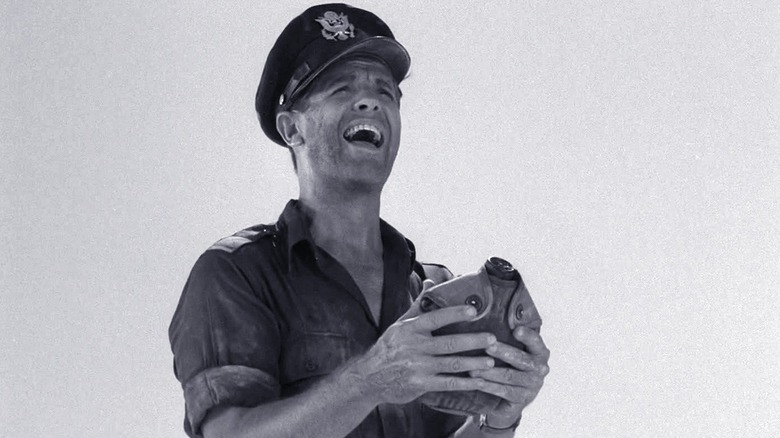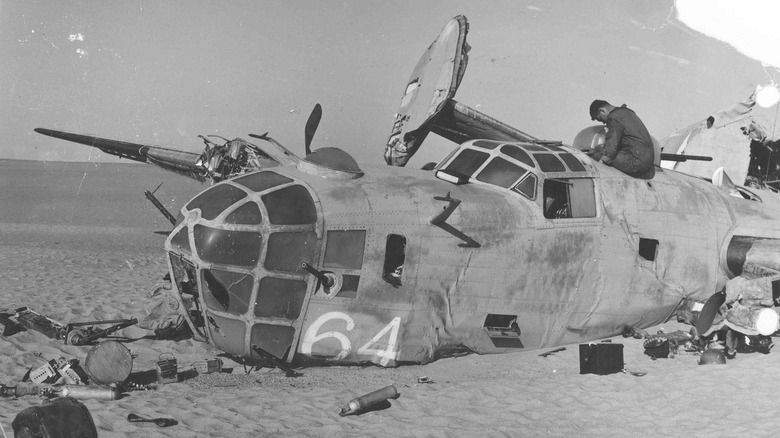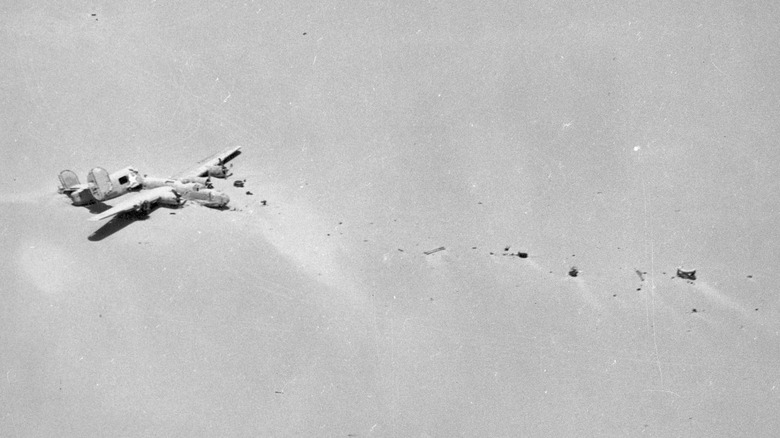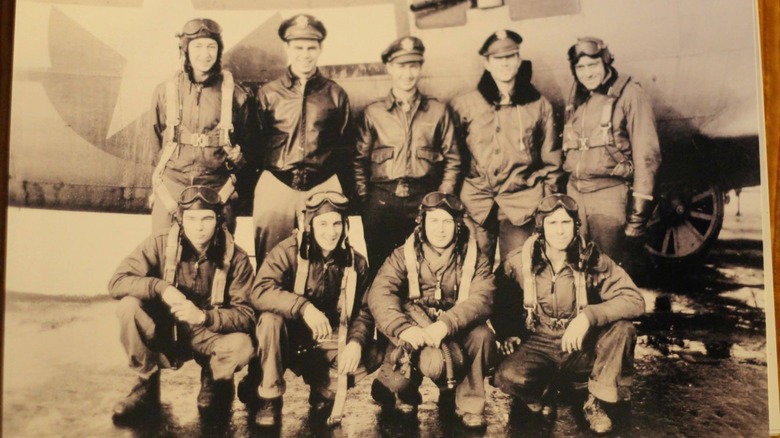The Real-Life Military Mystery That Inspired A Classic Twilight Zone Episode
"The Twilight Zone" has caused many sleepless nights with its strange and scary tales, but it's hard to beat reality when it comes to tragedy and horror. Such is the case with the first episode of season 2, "King Nine Will Not Return," which aired in 1960 and featured a mystery ripped straight from the headlines.
"King Nine" stars Robert Cummings as Captain James Embry, the pilot of a B-25 bomber called the King Nine, who regains consciousness after crashing in the desert during World War II. The rest of the crew appear to have vanished into thin air; Embry remembers he never told them to bail out, and all of the parachutes are still inside the plane. As he wanders around the area in search of his crew members, he catches glimpses of them from a distance, smiling at him, but the phantoms disappear when he tries to approach them. Captain Embry begins to wonder if he's still unconscious and dreaming, or dead and trapped in limbo, or perhaps even experiencing delusions inside a military asylum.
His final guess turns out to be closest when he wakes up in a hospital in 1960. It's revealed that Embry wasn't actually flying the King Nine when it crashed; he had stayed home due to an illness, and another pilot flew it to its doom. A newspaper article about the wreckage of King Nine being discovered in the desert 17 years later triggered a fugue state in which Embry was forced to wrestle with his survivors guilt over not being there to save his crew. But there's an eerie final twist: Embry's shoes somehow have sand inside them.
It's a more down-to-earth tale (so to speak) than many episodes of "The Twilight Zone," and perhaps that's because "King Nine Will Not Return" is largely based on a true story.
The mysterious disappearance of the Lady Be Good
The real King Nine was a B-24D Liberator bomber called the Lady Be Good, whose fate was a mystery for 16 years. The aircraft and her crew disappeared on April 4, 1943, after returning from a bombing mission in Naples, and the wreckage wasn't found until May, 1959. Why did it take so long to find the plane? Because she crashed in the Calanshio Sand Sea in the Libyan Desert: a 38,000 square mile expanse that forms one of the most inhospitable regions of one of the most inhospitable deserts on the planet.
The group of British geologists who discovered the Lady Be Good's resting place were surprised to find no trace of the nine-man crew. Despite the baking desert heat, the water jugs in the plane were still full, and food supplies were intact as well. According to "The Twilight Zone Companion," this was described by the Air Force as "one of the greatest mysteries in aviation history," a label that "The Twilight Zone" creator Rod Serling found to be irresistible inspiration for one of his spooky tales.
But while the Lady Be Good may have been a mystery at the time when Serling was writing "King Nine Will Not Return," it had been solved by the time the episode actually aired in September 1960. And as the final days of the Lady Be Good's crew were pieced together, the mystery was unmasked as a nightmare.
Stranded in the desert
One key detail in "King Nine Will Not Return" differs from the true story: when Captain Embry checks the plane, he finds that the parachutes have not been used. When the Lady Be Good was found, its parachutes were missing, which quickly led to the conclusion that the crew must have bailed out before the plane crashed.
All of the crew members were new to the Lady Be Good, having arrived in Libya less than a month prior to embarking on their final mission. At 12:12 a.m. on the day of its disappearance, a radio direction finder (RDF) station near the military airfield that the Lady Be Good was due to return to received a call from pilot Lt. William Hatton, requesting their inbound bearing. As documented in Dennis E. McClendon's book, "The Lady Be Good : mystery bomber of World War II," a "fatal mistake" resulted in the crew receiving an incorrect bearing from the RDF station, and Hatton could not find the airfield. With fuel running low, the crew eventually decided to bail out into the darkness. They were expecting to land near the shore in the Mediterranean Sea. Instead, they landed in the lethally arid Calanshio Sand Sea.
Bombardier John Woravka's parachute failed to deploy properly, and when his remains were later discovered it was clear that he'd died on impact. The other eight regrouped on the ground and began trekking through the desert, hoping to reach some kind of sanctuary. They never found it. In 1960, after the Lady Be Good had been rediscovered, a search for the crew was launched. Over the following months, all but one of the bodies were discovered, along with two diaries in which the crew had recorded their final days.
A survival story with no survivors
"King Nine Will Not Return" isn't the only work that was inspired by the Lady Be Good. The 1970 TV movie "Sole Survivor" was also loosely based on the bomber's fateful final flight, imagining the dead crew returning as ghosts to await the repatriation of their bodies. Elleston Trevor's novel "Flight of the Phoenix" (and its movie adaptations) also draw details from the story, with the notable change of having some of the Phoenix's passengers survive.
But despite the technicality that the Lady Be Good's crew did not survive, theirs is still a survival story — and quite an incredible one. The eight crew members who made it safely to the ground walked 65 miles through the desert over the next four days, sharing half a canteen of water between all of them. In one of two small diaries found with the bodies, co-pilot Robert Toner notes that each of them only drank a single cap of water on the second day. Flight engineer Harold Ripslinger, author of the other diary, says that by their third day this had been cut down to a single teaspoon. By the fourth day, they were down to just a few drops each ... and then their water ran out.
By the fifth day, five of the crew members were no longer capable of walking. "All wanted to die during noon it was so hot," Ripslinger wrote. "All want to die," Toner concurs. But the three who could still move — gunners Guy Shelley and Vernon Moore, and Ripslinger — strove onwards, hoping to find help and bring a rescue team to the rest. Ripslinger walked another 21 miles before finally succumbing to the desert. Shelley walked more than ninety miles altogether, a third of that distance covered without drinking a single drop of water.



